Author: Grant X. Storer, MS IDEC ’23
How I Ended Up In Chiapas
Ever since I read Dr. Bruce Wydick’s book, “The Taste of Many Mountains”, during my final quarter at Seattle Pacific University, I’ve been obsessed with coffee; not just as a beverage, but as a topic for economic development. I wanted to learn everything I could about coffee, and where the real opportunities for sustainable and equitable coffee production could be found. Initially, I started off as a barista, but then worked as a coffee educator, and eventually a coffee roaster. After four years in the industry, I decided to join the IDEC program in the fall of 2021 to help take me to the next level in this journey of sustainable development.
In that first semester, Dr. Jesse Anttila-Hughes reached out to me and connected me with Father Stephen Pitts, a USF IDEC alum who is in his second year of a PhD program at the University of Minnesota (UMN). He had previously done field research, working with an indigenous Mayan coffee producing cooperative in Chiapas, Mexico, and now had the opportunity to return to Chiapas with an exciting new project. He was working with Chris Boyd-Leon, a fellow PhD student at UMN, and was looking for an additional collaborator.
He explained to me the idea of running a lab-in-the-field experiment with coffee farmers, where participants would play a series of games where they have to decide on who to sell their coffee to between two potential buyers under various conditions. The question this experiment explores is: how much of a role do relationships and structural support from the local cooperative play in a producers’ decision to work with the cooperative? If another buyer shows up with a higher price, will the producer always maximize short-term income or do they continue to sell to those that they have an established relationship with?
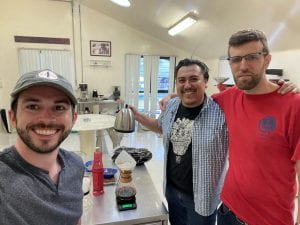
(Left to right: Grant Storer, Alex Rodríguez Márquez, and Stephen Pitts in the Bats’il Maya coffee lab)
A research grant from The Center for International Food and Agricultural Policy, and sponsorship through the USF Student Travel Fund opened the opportunity for us to conduct a full six-week study this summer, and additionally, a one-week trip to pilot test this project in Chiapas that Stephen and I conducted over spring break.
Providing Value to the Community
The organization we would be working with is called Yomol A’tel, a Jesuit organization that works with the Tzeltal Mayan people in rural regions of Chiapas, Mexico. They have multiple subsidiaries, but their main focus is coffee, as it is the primary means of income for most people in these villages. But what makes this organization unique, is they encompass the entire coffee supply chain. There are multiple steps to get from farm to the packaged product on the shelf, and typically this requires multiple intermediaries. Generally, the coffee producer will sell unprocessed coffee cherries, or parchment coffee to a local buyer (most cases to a cooperative). From there, coffee is processed to the exportable “green” coffee, that is sold to an import/export middleman, who will then sell that coffee to a coffee roaster. The roaster converts the green coffee into the consumable coffee beans, and either sells directly to consumers, or to wholesalers/cafes who can sell using the roaster’s brand or white-label the product under their own name. During this whole process, the value of coffee can easily increase 10x in price from the original sale to the farmer.
Yomol A’tel has taken on an ambitious approach to providing equity to coffee farmers by creating subsidiaries that capture the entire spectrum of that value chain. Bats’il Maya, is the coffee cooperative that buys the coffee from the farmers, and assists farmers in technical assistance, and provides a stable price premium offering to further benefit coffee farmers. These added services come from Bats’il Maya also being a coffee roaster, and roasts locally in Chilon, Chiapas Mexico.
Additionally, They also have their own coffee brand and multiple cafes across Mexico called “Capeltic Nuestro Café.” By controlling all aspects of the supply chain, Yomol A’Tel is able to reduce costs to each leg along that supply chain, and put more emphasis in supportive measures to the coffee producers. This was the subject of a 2018 documentary called “A Six Dollar Cup of Coffee.” They have even branched out with additional brands that process and sell honey, and scented soaps (Women-led cooperative called: Xapontic).
Lessons learned in the Field
When we set out for Chiapas, our objectives were to: reconnect with cooperative members and leaders, obtain approval from the community to conduct our study, observe the logistical requirements to reach remote villages for study, visit cooperative member coffee farms, and ultimately to pilot test the experiment with cooperative volunteers. What was not on the agenda were 4 lessons that I would be taught along the way.
Lesson One
On our first day arriving in Chiapas, I was taught one of the most important rules about field research: no matter what you plan, it will always end up taking twice as long. It’s roughly 125 miles from the Tuxtla Gutiérrez airport to the town of Bachajón, which is about as far of a drive as it is from San Jose to Sacramento. However, this drive is expected to take over 4 hours. What didn’t show up in any of our notes is that construction would be taking place in what seemed like every ten miles. After 8 gruelling hours in a taxi later, we finally arrived at the Jesuit mission that would be hosting us in Bachajón.

(Outside the Jesuit Mission in Bachajón)
Lesson Two
The next lesson I learned is that it takes a community to make real progress. Once we had our first meeting with the program director of the Bats’il Maya coffee cooperative, it became clear that we needed to set up numerous meetings with people throughout the community while we were here. Stephen turned to me at one point and repeated an old proverb: “If you want to go fast, go alone. If you want to go far, go together.” The first half of our trip was primarily meeting with people who were part of the coffee roastery, part of the cooperative, the Jesuit church, and community leaders. After all these meetings, there was the big monthly Bats’il Maya meeting where all the community leaders and directors met. It was there that we introduced our project, and stated how we would need to travel to each of their villages, stay all day running experiments with members of their community, and even stay the night in most cases. We needed their approval and their support since many potential participants will need to be available and travel possibly several hours to meet us in the villages we will be at. Their response was loud and clear: they will support us in any way they can.

(Analysts from Mesusyet reporting on coffee and honey production to the Bats’il Maya board members)
Lesson Three
The third lesson I learned is to remember you are stepping into a world that keeps on moving despite your presence. When you travel to conduct field research, much of your daily life gets put on hold, and everything you do is an event. For everyone else, it’s just another Wednesday.

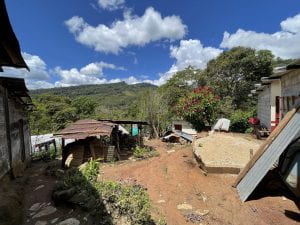
(Inside the village center of a coffee-growing community)
The day that we got to visit coffee farms, we had to get up early and take a pickup truck through rugged dirt roads for two hours up into the mountain ranges. There are only a few things that can contest the beauty of a sunrise drive overlooking densely covered coffee-growing mountains. When we arrived at the first village, we were warmly greeted by everyone, and they quickly made us all breakfast with coffee roasted over a fire stove. We then walked down the steep hillside and toured one of the coffee farms of the village. A point of emphasis in my own research has been the environmental factors pertaining to coffee production, and I’ve learned how maintaining a host of large trees, like banana and avocado trees, provide many environmental benefits. One of these benefits is that these larger trees provide a shade canopy that limits sun exposure. Counterintuitively, this is a good thing for coffee, because it not only slows the production cycle down to produce richer flavors, but it also lowers the temperature underneath the canopy; actively delaying some of the effects of climate change. These were what I had read about, but it’s a different learning experience to step out of a hut in temperatures that were quickly reaching 90 degrees, and walk into a farm that is essentially a forest and no longer need to wear sunglasses and feel the temperature immediately drop by 10 degrees.
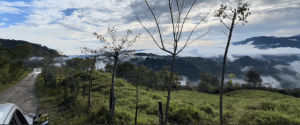
(View from the back of a pickup on our way to visit coffee farms)

(looking up at the tree canopy within coffee farm. Trees with large leaves are banana trees)
We then returned to the village center, where members of the women’s cooperative introduced themselves and showed us how they use various aromatic plants to create scented soaps. This cooperative is the female-led counterpart to the male-dominated coffee-crop cooperative. This spinoff is wholly owned and operated by women, as women from these communities are not only the producers but sit as board members as well. After introducing themselves, and explaining the operation, they asked us to introduce ourselves and our work. After we did, one of the women sheepishly said something in Tzeltal, which caused all the other women to laugh. The translator said, she thanked us for explaining who we were and what we were doing, because she was so confused and had no idea what these random people were doing walking around their village. That is when I realized that I had assumed this was an anticipated day of visitors that was as big of a deal as it was for me to be there. But now I realized it’s just Wednesday, and we probably just interrupted breakfast.
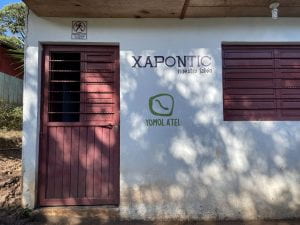
(Xapontic is the soap spinoff of Capeltic, the coffee brand. These are under the Yomol A’tel umbrella)
Lesson Four
The last lesson learned came during the pilot test of our experiment. We had set up a prototype of the experiment that could be run on tablets that we could take into the villages to run. I created a simulation that could run all the various scenarios for each game and made it easy to run through each round efficiently. With this in mind, we initially planned for participants to play 4 games that had 20 rounds in each game, for a total of 80 rounds that could easily be played in less than an hour. However, that was derailed as we realized there may be literacy issues and so we pivoted to a tactile form of the games. We used numbered ping pong balls to represent harvest yields and used the function of participant drawing from burlap bags to create randomization.
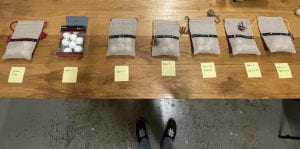
(L to R: Harvest yield distribution, harvest disbursement, price 1, price 2 mean distribution, price 2 50 peso mean, price 2 70 mean, and price 2 90 mean)

(Volunteer drawing from bag to determine price 2 mean)
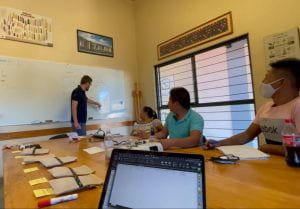
(Stephen explaining the various scenarios of price 2)
We had three volunteers from Bats’il Maya participate in the pilot, and we played only 4 rounds with each participant. Thus we had a grand total of 12 rounds of played data for our experiment; much less than the 80 rounds we intended on playing. How long did it take to play 12 rounds? One and a quarter hours! We hadn’t accounted for the fact that ping pong balls bounce around, and that we had to walk over to the participant each time for them to draw from a bag, which occurs four times in a single round. This made us realize that there is beauty in simplicity and that systems of development should always strive for the minimum viable product of the intervention. To make it as tangibly simple as possible with the least moving parts, and from there build a robust system.
While it was a challenging spring break, this experience has taught me important lessons that will help me be better prepared for when our full team returns to Chiapas this summer to conduct our official experiment.
